

Some of the best images of Jupiter taken so far are shown here. They all used the AO-2 adaptive optics system, and show nearly diffraction-limited images taken during moderately good seeing in San Diego. The images were taken with a 10" planetary Newtonian masked down to 9.5", projected to F/59 (14.2 m EFL), an SBIG ST-7 CCD camera (binned 2x2 pixels for 382x255 images, pixel scale = 0.26 arcsec/binned pixel), and an SBIG CFW-8 Color Filter Wheel using their new IR-blocking color filters. Exposures varied, typically several seconds long. Each individual exposure was gently processed and merged with Cyanogen Production's MaxIm DL. The intent of the image processing was to keep as much detail as possible without distortion.
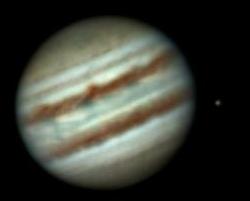
Jupiter, November 15, 1999. RGB exposures 6 seconds/4 seconds/8 seconds in good seeing. Europa seen on the right side. The image was processed only with unsharp masking; attempts with maximum entropy resulted in artifacts in the center of the disk.
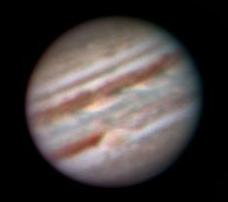
Jupiter, November 26, 1999. RGB exposures 3 seconds/2 seconds/4 seconds in good seeing. The Great Red Spot is seen near the center of the disk. The image was processed only with unsharp masking.
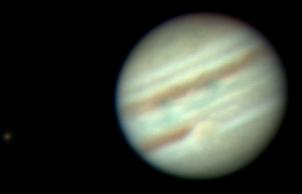
Jupiter, December 8, 1999. RGB exposures 2.7 seconds/1.8 seconds/3.6 seconds in only average seeing. The Great Red Spot is seen near the center of the disk, and Europa is seen on the far left side of the frame. The image was processed only with unsharp masking.
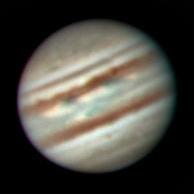
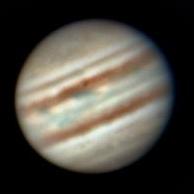
Jupiter, December 29, 1999. RGB exposures 3.5 seconds/2.5 seconds/3 seconds in average seeing. The two images show rotation over about a 45 minute period. The images were processed only with unsharp masking.
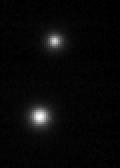
Jupiter's moons Europa (upper) and Ganymede (lower) on January 15, 2000. The seeing wasn't good enough to image Jupiter, but since these two moons were close together, I could demonstrate the difference in sizes. This is an average of 7 exposures, each 0.1 second long, through a clear filter with the AO-2 turned off. No processing was done to the pictures. Ganymede measures 1.7 arcsec in this picture (at 0.26 arcsec/(binnned 2x2)pixel at 14.2 m focal length). Europa measures 1.3 arcsec. These were determined by plotting the pixel intensities through a horizontal section through the center of the images, and measuring the FWHM diameter. The measured dimensions are a result of the telescope diffraction and seeing effects. Once the seeing gets better next summer, I hope to show features on Ganymede.
All text and images are owned by Stellar Products, 1992-2003. Any use by others without permission of Stellar Products is prohibited.
Links to other Stellar Products pages: